Today I will tell you about our experience in this kind of modification of multiplayer game mechanics and their adaptation for children from seven to eleven years old using the example of the new online game "Formula 1 + 1". For several months of work in test mode (the game is available only for 10% of platform users), 95 thousand players took part in it, and the most persistent spent more than 100 hours in it, that is, more than 6 thousand games. I will try to show you how we implement lennification - a process where we do not try to make learning interesting, but rather add an element of learning to the game.

Race map in the game "Formula 1 + 1"
The game "Formula 1 + 1" is a multiplayer race where the speed of the car is influenced by the solution of examples of oral counting: the faster and more correct answers the player gives, the faster he will go. For winning the race, the player receives experience (rises in the rating) and coins, which can be used to buy new, more powerful-looking cars.
What goals did we set
When the game was conceived, we wanted it to be truly interesting for children and at the same time develop skills from the school curriculum for grades 1-4.
We aimed:
Take into account the peculiarities of children's perception
The game is intended for elementary school students, and at this age it is difficult for children to stay focused for a long time. And the very competition with a rival in children is much more emotional than in an adult, which means that it takes a lot of energy. So that the child does not get tired too quickly and does not "burn out", we took into account the counting rate for each class, made the runs short, while adding several elements of motivation.
Show the value of the game to adults
The success of the game in children largely depends on their parents, because it is they who usually decide how much time the child can spend at the computer or in the smartphone. The game should appeal not only to the child, but also to his parents, proving its usefulness and harmlessness.
On the main screen of the game, we have placed a button leading to the section with personal statistics of the "racer". It reflects the success in each type of races - the number of victories and correct answers as a percentage. This data clearly shows the parent what his child has succeeded in and what is worth improving.
Security in terms of authorization is provided by the Uchi.ru platform. There are also no ads in the game, a loot box mechanic - all improvements are available only through in-game currency.
Game mechanics
Core gameplay
As a basis, we took the mechanics of a game popular with children on our platform: solving arithmetic examples for speed. Added generation of arithmetic examples - each time the player sees a new task. This makes the game much more fun and increases replayability, which means players improve their counting skills.
In favor of the multiplayer comes our successful experience of holding various competitions on the portal and the abundance of successful multiplayer mobile games on the market: Brawl Stars, Clash of Clans, Clash Royale and the like. So we got a race, where in an online race two students compete in who will reach the finish line faster.
We were prompted to choose the genre of online racing by letters from users, in which children often asked to "make a game about cars."
The racing races are short-lived - only five arithmetic examples with three answer choices, which are simultaneously shown to both players. The entire race takes about one and a half minutes.

Choosing the correct answer, the player propels his car to the finish line. The dial on the left shows the number of the current question, on the right - the timer counting down the time allotted for the answer.
Minor mechanics
It is difficult to affect a child's arithmetic ability if he quickly loses interest in the game, becomes reluctant to play it, or abandons it altogether. We have to keep him in the game long enough and motivate him to improve the results. For this, the game provides several tools.
To add some variability (read replayability) to the race, we've come up with a quick response bonus. If the player gives the correct answers faster than the opponent twice in a row, his car will move forward a little more.
Races can be carried out on different tracks. There are five of them. Each has its own type of arithmetic examples: addition, subtraction, multiplication, division and mix, where all examples are found.
In each category, questions are generated during the game. Unlike pre-written examples, this method not only greatly expands the number of tasks that a student can meet, but also gives us the ability to adjust their difficulty depending on the class. We have identified four levels of difficulty, which correspond to the norms of 1, 2, 3 and 4 (and higher) classes.
For example, students in grade 1 can only count within 20, and in grade 4, children solve examples with three-digit terms and a transition through one dozen. Not every adult can cope with the tasks of the last level without a calculator - only ten seconds are allotted for one example. Try now to quickly complete the addition task with two transitions through tens: 574 + 349.

The opponent can be a player with comparable success, selected using the algorithm from among the students online, or a friend previously added to a special list.
Although the portal has a huge audience of 8 million students, players may lack online rivals. In order not to make children wait a long time for a suitable play partner, we introduced bots into the game. The opponent bot looks like a normal player. Based on the player's rating, the bot is assigned the ratio of correct and incorrect answers: strong players get a strong bot, weak ones - a weak one.
To avoid match-fixing, we do not give rewards for rides with friends.
Character: details and nuances
The three components of the player character
Children love to imitate their parents, they love the attributes of adulthood. We have tried to take this into account, so when you first enter the game, each child receives a game car license. Filling them in, the player creates his character: he chooses an avatar, a game name and a car number for in-game identification.
The name can be selected from the drop-down list of adjectives and nouns. This was not done by chance. Firstly, because it would be incorrect to display the real name and surname of the child in the game - the game name allows you to maintain anonymity. And secondly, imagine what would happen if you let the children show off their sense of humor and come up with a play name for themselves. At the very least, we would have to introduce name moderation, which would greatly complicate the process for everyone.
The car number consists of the initials of the game name, as well as numbers and a region code, which the player can select manually or generate automatically. For children, choosing a number and a region code becomes a game in the game: some try to find a beautiful number, others - similar to the number of the parents' car.

Login 0+
The game lives on our main platform, so authorized users come to it. This saves us from the complexities of the child's personal data, but gives us information about his class and school.
Motivation
1. Reward for the game played
At the end of the race, the student always receives rewards - experience points and coins. Experience points are needed to increase your level. This is the simplest motivation tool. The more you play, the higher your level, and it doesn't matter if you play well or not. For coins, you can buy new cars, cooler and more beautiful.
By the way, when we tested different models of cars with children, they called the coolest cars not supercars and not novelties of the car industry, but the models that they saw in the family.

2. Pumping in several directions
Improving your personal fleet is not limited to buying a new car. After completing certain tasks, the player can repaint the body or add other visual effects. Some tasks encourage the number of correct answers or a streak of victories, while others motivate you to regularly enter the game, to conduct more races per day. Thus, the machine becomes a showcase of the student's achievements, which other players constantly see.
3. Personal rating
Another tool that adds interest, depth and motivation, and also allows the student and parent to assess the level and dynamics of arithmetic ability, is the ranking. The game becomes even more interesting when, for example, a second grader can look at his place among the other second graders, observe the dynamics and try to climb to the very top.
To calculate the player's rating, we use the Elo coefficient, which is often used in sports (chess, football, tennis). The counting ability of children varies greatly, not only from year to year, but also within the class. Someone learned to count before school, and someone in the 1st grade only gets acquainted with numbers. Therefore, we must select opponents, taking into account not only the player's class, but also his abilities. Otherwise, a weak child will be sad to play with strong players, and a strong one will quickly get tired of constantly winning.
Elo rating is a method of calculating the relative strength of players in doubles games. All new players receive a starting rating value. After a race with an opponent, the rating of both changes depending on the winner and the rating values of both players. If a child beats a partner with a higher ranking, his rating will grow more than if he beats an opponent in a lower place. Thus, a strong player, constantly winning, will increase his rating until he reaches his peers, and the chance of winning is 50/50.

Players with a lower level may be higher in the ranking.
4. Class rating
As our experience shows, children are happy to compete in whole classes, which is why we have added a class rating to the game. To solve the problem of different class sizes (from a few students to 35) and excessive zeal for first places, we have developed a separate system for calculating the class rating.
- The player receives points for the class rating only for the first five races per day in the "Mix" mode.
- The number of points received depends on the size of the class. If every child in each class races five races a day and wins, then these classes will earn the same (maximum) class points regardless of the number of students. This amount becomes the basis for calculating the rating points for all classes in the game.
- ( ) , , ( ⅓ ). , 1–4 .
- , — 890 100. , . , 30 198 .

We ended up with a game that is very similar to a regular online game, but with a real educational effect, and at the same time it is adapted for children 7-11 years old. The main mechanic of the game is to improve the child's counting skill. The first results show that children are ready to spend a huge amount of time in it: at the time of this writing, we counted more than 95 thousand active players (despite the fact that the game is still in test mode and only 10% of Uchi.ru students are available). The reaction of the parents to the “Formula 1 + 1” is also positive.
The most difficult and interesting in game development is ahead. We have to figure out in more detail what exactly made the game popular and what was superfluous, to study the data of many metrics and conduct interviews with children, parents and teachers.